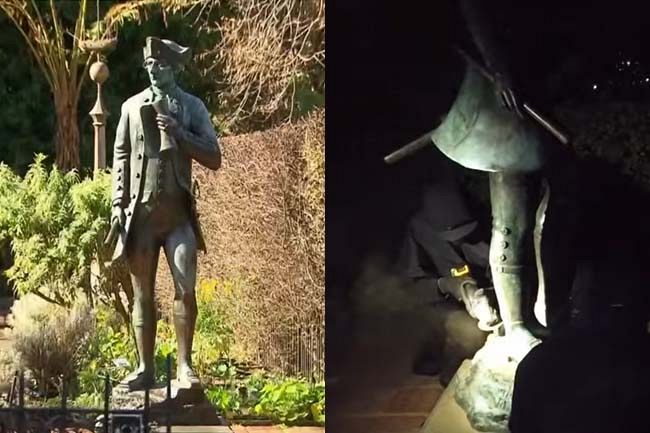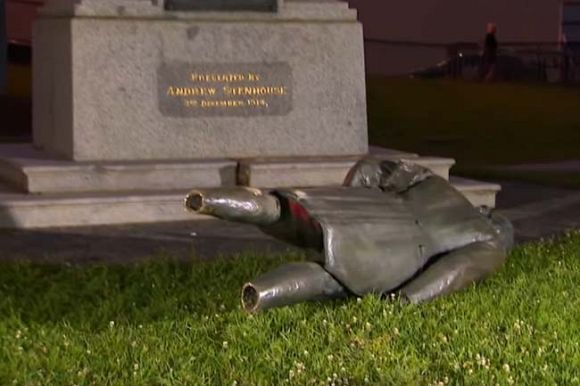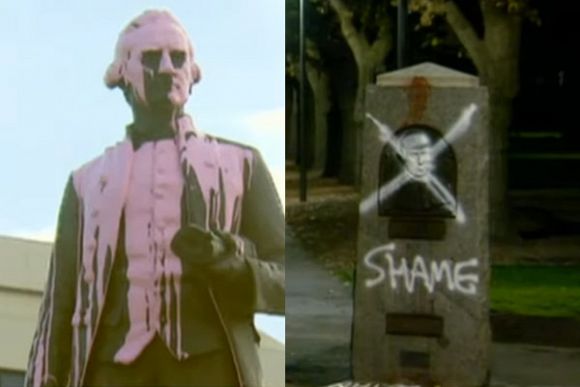The mainstream media has sensationalised the toppling of Captain Cook statues around the country, but there are deeper issues to discuss than bronze monuments. Rosemary Sorensen reports.
ANOTHER CAPTAIN COOK toppling from his pedestal in a Melbourne park has provided another opportunity for Australia’s rant-central media network to hyper-ventilate about how this is not just a piece of metal, this statue. It’s our “culture”.
Frankly, the question is not whether this is a criminal act against Australian history, but how such a hideous statue came to stand in this green and lovely place.
Thanks to an entirely unhysterical report in The Age, written by Alex Crowe, we are reminded that this latest vandalised bronze stands – stood – alongside Cooks’ Cottage in Fitzroy Gardens, midway between Parliament House and the MCG.
Cooks’ Cottage was the Yorkshire home of James’s parents, which was, for puzzling reasons, bought by Russell Grimwade in 1934.
Knighted in 1950, this benefactor was into all kinds of big and successful businesses. Sir Russell, apparently, had a passion for colonial history, thus the purchase of this house which gestured towards (I think that’s the correct term here) a connection between Cook, so often confused with other blokes whose endeavours were not so seaworthy and a part of Australia he hardly set foot in.
Note the change from Cook’s Cottage to Cooks’ Cottage, which appears to be a subtle corrective to what generations of Melbourne school students believed (and which is still, apparently, believed by those culture warriors on loony conservative television shows).
No, Cook didn’t live in Australia and he certainly didn’t discover it, even though, in August 1770, he ‘claimed the whole of the east coast of Australia for Great Britain’ (despite the fact that, during his time sailing up the coast, he saw people on the shore and noted they weren’t pleased to see the ship trying to land).
That line about Cook claiming the whole of the east coast is a quote from a Monuments Australia site, which lists another Cook statue and thus another potential target for the Instagrammers who boasted that the Fitzroy Gardens felling, following that of a statue in the Catani Gardens on St Kilda’s foreshore, removes 'the last remaining Cook statue in the city'.
In that city, maybe, but alongside St Paul’s Anglican cathedral in central Bendigo, a similar Cook bronze stands on a plinth, hand on hip, gaze slightly to the left, pondering, no doubt, what his legacy will be.
His breeches are tight, his frock coat dressy, but at least the creator of this 1906 monument, one John Walker, a Bendigo local, got the body proportions more or less right. The Cooks’ Cottage one, made in 1973 and gifted (!) to the City of Melbourne in 1996, appears to be trying for a less naturalistic look, which has turned our James into a trollish fellow with an enormous head and Trump-tiny hands, who appears to have forgotten to put on his trousers.
A couple of attempts have been made to turn this statue-felling into a hot-take cultural issue. Are these vandals criminals? Should statues commemorate colonisers? (The tub-thumpers’ line, apparently, is that Cook was an explorer, not a coloniser, thus relying on our indifference to history’s facts to whitewash that role.)
Alongside the destruction – both covert and official – of such monuments, there’s also a move to establish new statues of women in history to counter-balance history’s privileging of masculine roles.
Last year, the Deputy Lord Mayor of Melbourne, Nicholas Reece, called the statuary under-representation of women a “moral hazard” and said there was overwhelming interest from the public about who gets put up on plinths.
Challenging the assumptions embedded in these public monuments does bring with it some healthy and helpful airing of history. If there is such enormous interest in this, maybe it’s time, too, for a renewal of the discussion about not just who and what public monuments memorialise but also how.
Is there any artistic worth in a quasi-naturalistic representation cast in bronze, static and ugly, plonked on a plinth? If it’s not there to be beautiful, what’s the point?
Rosemary Sorensen was a newspaper, books and arts journalist based in Melbourne, then Brisbane, before moving to regional Victoria, where she founded the Bendigo Writers Festival, which she directed for 13 years.
 This work is licensed under a Creative Commons Attribution-NonCommercial-NoDerivs 3.0 Australia License
This work is licensed under a Creative Commons Attribution-NonCommercial-NoDerivs 3.0 Australia License
Support independent journalism Subscribe to IA.














